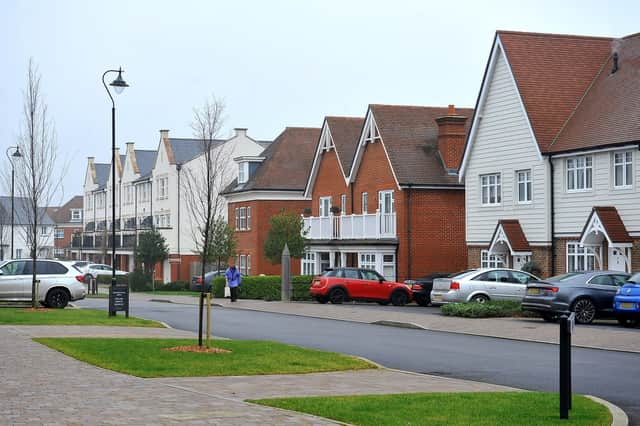How are Sussex housing targets calculated and what happens if councils fail to keep up with them?


Here, we focus on housing targets and explain how they are calculated. We also explore the tests the government sets councils to ensure building continues at the required pace and the penalties faced if they fail.
Our campaign calls for councils to have greater powers to determine their own housing needs, free from the influence of centralised calculations. See our campaign launch piece here.
What is housing need and how is it calculated?
Advertisement
Hide AdAdvertisement
Hide Ad

The government gives all local authorities a figure, known as ‘housing need’, which is its calculation of how many homes are needed. This does not take into account any local issues, such a lack of available land.
This figure is calculated using a formula known as the Standard Method.
Centre for Cities defines this as a ‘formula which divides up the national target for each place based upon predictions of local household growth and affordability’.
“Less affordable cities are given slightly higher supply targets in recognition of their higher need,” it adds.
Advertisement
Hide AdAdvertisement
Hide AdIn Sussex, the gap between house prices and earnings is high, meaning it faces a greater pressure to build more homes.
According to the Office for National Statistics, the ratio of gross annual house prices to annual earnings in Sussex in 2020 ranged from 8.16 (Crawley) to 14.09 (Chichester) with an average of 11.09. The average for England was 7.84.
Do councils have to provide their housing need in full?
Although it is not technically mandatory to meet the housing need in full, it can prove very difficult for councils to argue otherwise.
National guidelines state there may be ‘exceptional circumstances’ which mean councils can provide a different figure.
Advertisement
Hide AdAdvertisement
Hide AdThere is however no specific list defining what these exceptions are.
Lack of space due to land in the national park or Areas of Outstanding Natural Beauty are the sort of constraints which might be taken into account – but councils will have to have ‘robust evidence’ to prove they cannot meet their housing need, guidance warns.
What is a housing requirement and how does it differ to housing need?
Calculating how much land is available for housing is a key consideration when councils produce their local plans.
Advertisement
Hide AdAdvertisement
Hide AdThe figure a council finally arrives at and has approved – be it lower, on target or above target – becomes its ‘housing requirement’.
The task of delivering on that requirement then becomes the next challenge.
When updating their local plans, councils will have to consider the latest Standard Method housing need figure and explore if it can be met.
What happens if a council fails to deliver its housing target?
Advertisement
Hide AdAdvertisement
Hide AdIn most cases, responsibility for actually building new homes falls on developers, rather than local authorities.
But currently, the system penalises the councils if housebuilding does not keep up with the required pace.
If this happens, there is something called a ‘presumption in favour of sustainable development’.
This effectively makes it easier for developers to gain planning permission, even for housing in more contentious locations.
This is also known as the ‘tilted balance’.
Advertisement
Hide AdAdvertisement
Hide AdSavills explains: “The term tilted balance is used to define this passage of policy because when engaged, the tilted balance should change the ‘balancing exercise’ which the decision-taker – the planning officer, inspector or Secretary of state – makes when deciding whether or not to grant planning permission; from a neutral balance where if the harms outweigh the benefits planning permission is usually withheld to a tilted balance where the harms should significantly and demonstrably outweigh the benefits for permission to be withheld.
“The tilted balance therefore increases the prospect of planning permission being granted because it ‘tilts’ the balance in favour of approving an application.”
There are two primary ways in which this situation arises, explained below:
The Housing Delivery Test
The Housing Delivery Test compares the number of homes built in a council’s area against its housing requirement over a three-year period. It is published annually.
Advertisement
Hide AdAdvertisement
Hide AdThe figure used depends on the status of a council’s local plan. If a plan is out of date, the housing need figure will be used. The figure can change each year, based on the circumstances at the time.
If less than 95 per cent of the requirement has been built, councils must publish an action plan to set out how it will boost housebuilding.
In the worst-case scenario, where less than 75 per cent has been acheived, the ‘presumption in favour of sustainable development’ comes into play.
In Sussex, Adur, Worthing, Arun, Eastbourne and Hastings fell below the 75 per cent mark in the latest test.
The five-year housing land supply
Advertisement
Hide AdAdvertisement
Hide AdAs well as being tested on the number of homes built, councils must also identify enough land for new housing to be located on.
The government explains: “A five-year land supply is a supply of specific deliverable sites sufficient to provide five years’ worth of housing (and appropriate buffer) against a housing requirement set out in adopted strategic policies, or against a local housing need figure.”
Again, the status of a local plan depends on the figure used to calculate how much housing is needed per year.
Housing targets in the news
Back in 2020, the government consulted on changes to the way housing needs were calculated.
Advertisement
Hide AdAdvertisement
Hide AdAs Centre for Cities explains: “The government initially suggested that affordability now receive a much greater weight in a new Standard Method.
“Unaffordable places would have had to build more.”
The proposal was dubbed the ‘mutant algorithm’ and a high-profile campaign, with Arundel and South Downs MP Andrew Griffith playing a leading role, saw the change scrapped.
Instead, Centre for Cities said, Greater London and 19 urban local authorities faced a 35 per cent uplift on their housing need figure. Brighton was included on this list.
What do councils leaders think about housing targets?
As part of our campaign, we asked all council leaders in Sussex for comment.
Their replies are collated here
Comment Guidelines
National World encourages reader discussion on our stories. User feedback, insights and back-and-forth exchanges add a rich layer of context to reporting. Please review our Community Guidelines before commenting.